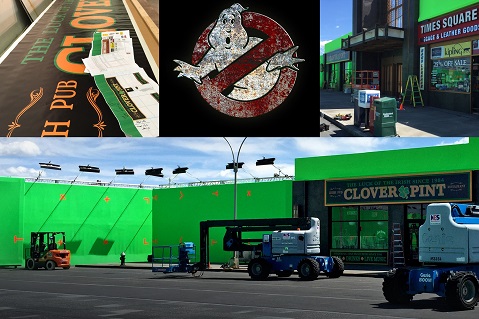July 18, 2016
Graphic Designer Uses Roland Printer/Cutter on Ghostbusters Set
The hotly anticipated remake of the 1980s pop culture classic Ghostbusters was released on July 15, complete with troublesome ghouls, a new Ectomobile and, this time, an all-female lead team made up of comedic heavy-hitters Melissa McCarthy, Kristen Wiig, Kate McKinnon and Leslie Jones.
To make the set as realistic as possible, producers turned to graphic designer Martin Charles, a veteran of film and television set design who regularly uses wide-format printer/cutters from Roland DGA (asi/18201) for his work. To date, he has worked on set design for more than 50 feature films and TV shows.

Charles, founder of SagaBoy Productions in Santa Monica, CA, used Roland’s SOLJET Pro 4 XR-640 wide-format printer/cutter and Eco-Sol MAX 2 inks to print a myriad of set elements for the newest Ghostbusters, from large building walls in Times Square and haunted mansions, to surface textures, to street signs and billboards, to small bottle labels. The XR-640 has built-in printing and contour cutting capability, while the MAX 2 inks provide accurate color and fine close-up detail.
“Rebooting this legendary movie franchise was a great opportunity and an intriguing challenge,” said Charles. “We needed to preserve all the familiar graphic elements while bringing in a few modern twists.”
Charles has partnered with Roland since 2006, when he was working on graphics for the film Miami Vice with Colin Farrell and Jamie Foxx. “He needed a wide-format printer that could print and cut colorful, intricate designs on vinyl to wrap the high-performance boats used in the movie,” Marc Malkin, Roland’s PR representative and copywriter, told Counselor. “He did some research and called Roland, the originator of the print/cut solution, and he has relied on us ever since.”
For this most recent project, Charles partnered with production designer Jefferson Sage to recreate everything from the Ghostbusters’ lab, to a simulated rock concert, to the streets of New York City, which included commercial signage, posters and wraps that transformed plain vehicles into taxis, police cruisers and emergency vans. The range of materials used includes artist canvas, vinyl media, photo paper, poster paper and adhesive fabric.
“It all translated into an incredible amount of work,” said Charles, who spent almost eight months working on the set and, for just one interior scene, printed more than 3,000 square feet of printed wallpaper graphics. “Fortunately, my Roland inkjet allowed me to print just about anything you can imagine on the set quickly and easily. That was crucial in meeting the tight deadlines dictated by the shooting schedule.”
